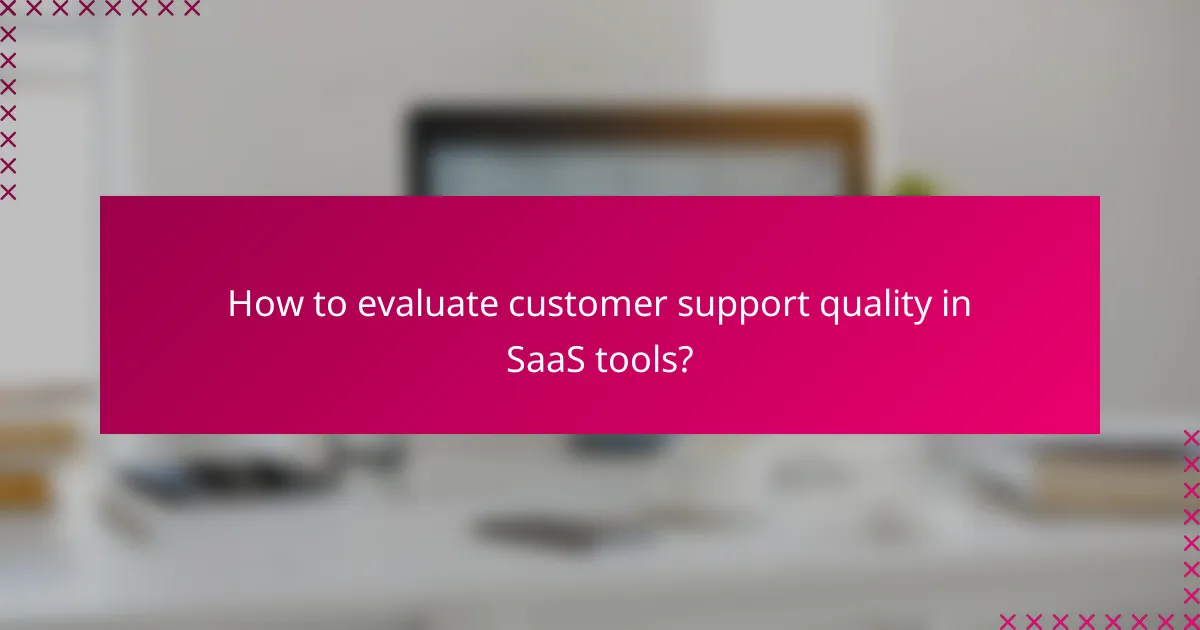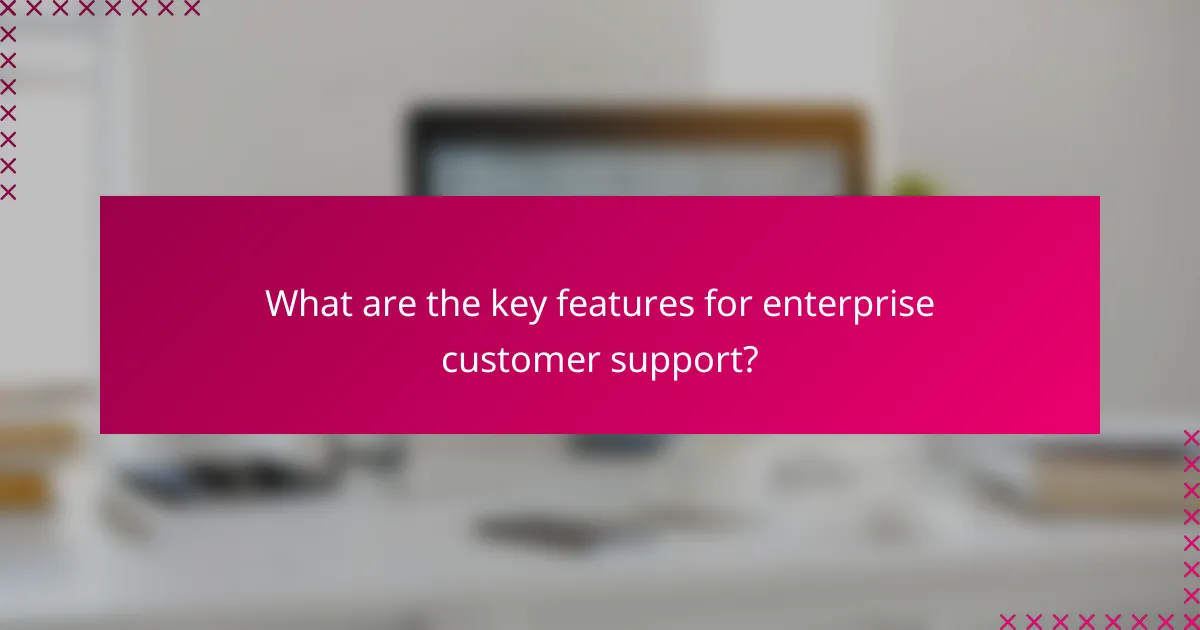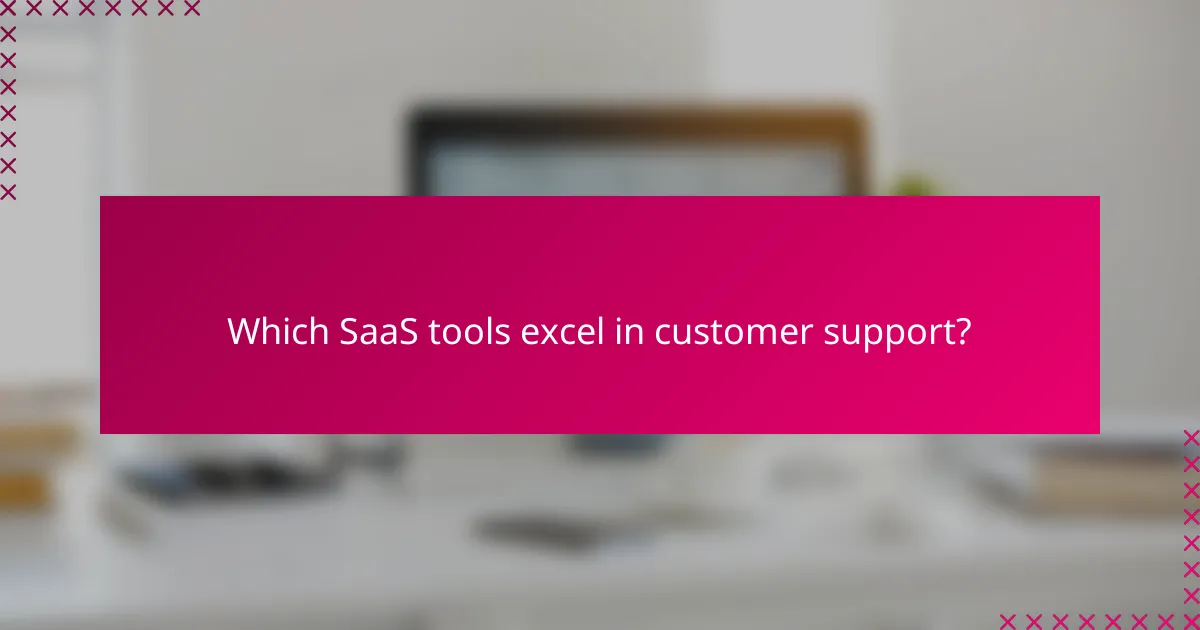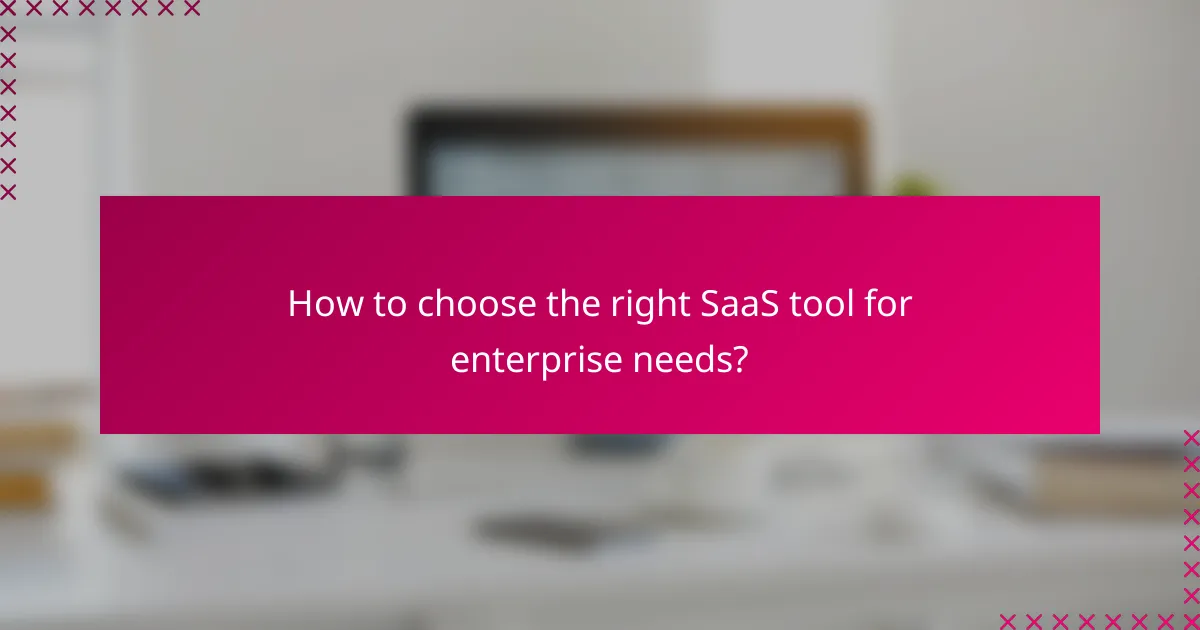Choosing the right SaaS tools for customer support is crucial for meeting enterprise needs and ensuring high-quality service. Key considerations include evaluating response times, support channels, and agent expertise, which collectively determine the effectiveness of assistance provided. Additionally, features like scalability and customizable reporting are essential for managing customer interactions and analyzing performance as businesses grow.

How to evaluate customer support quality in SaaS tools?
To evaluate customer support quality in SaaS tools, focus on response times, customer satisfaction, available support channels, and agent expertise. These factors provide a comprehensive view of how effectively a service can assist its users.
Response time metrics
Response time metrics indicate how quickly a support team addresses customer inquiries. Aim for response times in the low tens of minutes for live chat and single-digit hours for email support to ensure timely assistance.
Consider tracking both first response time and resolution time. First response time measures how long it takes for a customer to receive an initial reply, while resolution time assesses how long it takes to fully resolve an issue.
Customer satisfaction scores
Customer satisfaction scores (CSAT) gauge how satisfied users are with the support they receive. A typical CSAT score is derived from post-interaction surveys, where customers rate their experience on a scale, often from 1 to 5.
Look for CSAT scores above 80% as a benchmark for quality support. Regularly reviewing these scores can help identify trends and areas needing improvement.
Support channel availability
Support channel availability refers to the different ways customers can reach out for help. Common channels include email, live chat, phone support, and social media.
Evaluate whether the SaaS tool offers 24/7 support or limited hours, as well as the variety of channels available. A diverse range of support options can enhance user experience and satisfaction.
Agent expertise levels
Agent expertise levels reflect the knowledge and skills of support staff. Assessing this can involve looking at training programs, certifications, and experience in the industry.
Consider the complexity of issues typically faced by users. For technical products, ensure agents have specialized training or certifications to handle advanced inquiries effectively.

What are the key features for enterprise customer support?
Key features for enterprise customer support include multi-channel support integration, scalability options, and customizable reporting tools. These elements ensure that businesses can efficiently manage customer interactions, adapt to growth, and analyze performance effectively.
Multi-channel support integration
Multi-channel support integration allows enterprises to engage customers through various platforms such as email, chat, phone, and social media. This feature ensures a seamless experience for users, enabling them to reach out through their preferred channel without losing context.
When evaluating tools, look for those that unify interactions into a single dashboard. This can help agents track conversations and respond more efficiently, reducing response times and improving customer satisfaction.
Scalability options
Scalability options are crucial for enterprises anticipating growth or fluctuating customer demands. A good customer support tool should accommodate an increasing number of users and interactions without compromising performance.
Consider solutions that offer tiered pricing or modular features, allowing you to expand capabilities as needed. This flexibility can help manage costs while ensuring that support quality remains high during peak periods.
Customizable reporting tools
Customizable reporting tools enable enterprises to track key performance indicators (KPIs) relevant to their customer support efforts. These tools can provide insights into response times, customer satisfaction scores, and agent performance, helping businesses make informed decisions.
Look for platforms that allow you to tailor reports to your specific needs, including the ability to set benchmarks and visualize data trends. This can enhance your understanding of support effectiveness and guide strategic improvements.

Which SaaS tools excel in customer support?
Several SaaS tools are recognized for their exceptional customer support capabilities. When choosing a tool, consider factors like response time, ease of use, and integration with existing systems to ensure it meets your enterprise needs.
Zendesk
Zendesk is a leading customer support platform known for its robust ticketing system and multi-channel support. It allows businesses to manage customer inquiries via email, chat, phone, and social media from a single interface.
Key features include automation tools, reporting analytics, and customizable workflows. Companies often appreciate its scalability, making it suitable for both small businesses and large enterprises.
When evaluating Zendesk, consider its pricing tiers, which can range from basic plans to more advanced options, depending on the features required. Ensure that your team is trained to utilize its extensive capabilities effectively.
Freshdesk
Freshdesk is another popular choice for customer support, offering a user-friendly interface and a variety of support channels. It includes features like ticket management, a knowledge base, and customer satisfaction surveys.
This platform is particularly appealing to startups and small businesses due to its competitive pricing and free tier options. Freshdesk also integrates well with other tools, enhancing its functionality.
When selecting Freshdesk, assess your support volume and the specific features you need, as some advanced functionalities may require higher-tier subscriptions. Regularly review your usage to ensure you are maximizing its capabilities.
Intercom
Intercom stands out for its focus on conversational support, allowing businesses to engage customers through live chat and automated messaging. This tool is designed to enhance customer interactions and improve response times.
Intercom’s features include targeted messaging, user segmentation, and a comprehensive help center. It is particularly effective for companies looking to provide proactive support and build stronger customer relationships.
When considering Intercom, evaluate how its pricing aligns with your budget, as it can be on the higher end compared to other tools. Ensure your team is prepared to leverage its conversational capabilities to foster meaningful customer engagement.

How to choose the right SaaS tool for enterprise needs?
Choosing the right SaaS tool for enterprise needs involves identifying specific business requirements, evaluating pricing models, and assessing integration capabilities. A well-selected tool can enhance productivity, streamline operations, and improve customer support quality.
Assessing business requirements
Start by identifying the core functions your enterprise needs from a SaaS tool. Consider factors such as user capacity, scalability, and specific features that align with your business goals. For example, if your team requires robust customer support features, prioritize tools that offer comprehensive ticketing systems and live chat options.
Engage with stakeholders to gather insights on their needs and pain points. This collaborative approach ensures that the selected tool addresses the diverse requirements across departments, ultimately leading to higher satisfaction and productivity.
Comparing pricing models
Pricing models for SaaS tools can vary significantly, including subscription-based, pay-per-use, or tiered pricing structures. Evaluate these models against your budget and expected usage patterns. For instance, a subscription model may be more cost-effective for larger teams, while pay-per-use could benefit smaller enterprises with fluctuating needs.
Look for hidden costs such as setup fees, maintenance charges, or additional costs for premium features. A transparent pricing structure helps avoid unexpected expenses and allows for better financial planning.
Evaluating integration capabilities
Integration capabilities are crucial for ensuring that the SaaS tool works seamlessly with your existing systems. Assess whether the tool can easily connect with your current software, such as CRM systems or project management tools. Tools that offer APIs or pre-built integrations can save time and resources during implementation.
Consider the long-term implications of integration. A tool that integrates well today may need to adapt as your business evolves. Prioritize solutions that offer flexibility and support for future integrations to avoid costly migrations down the line.

What criteria should be used for SaaS tool selection?
When selecting SaaS tools, focus on criteria such as feature sets, vendor reputation, customer support quality, and alignment with enterprise needs. These factors will help ensure that the chosen tools effectively meet your organization’s requirements and provide reliable service.
Feature comparison matrix
A feature comparison matrix allows you to evaluate multiple SaaS tools side by side based on specific functionalities. Identify the key features that are essential for your business, such as integration capabilities, user interface, and scalability. Create a table listing these features against each tool to visualize strengths and weaknesses.
For example, if you are comparing customer support software, you might include features like ticketing systems, live chat options, and reporting capabilities. This structured approach helps in making informed decisions based on your enterprise’s specific needs.
Vendor reputation analysis
Assessing vendor reputation is crucial in SaaS tool selection, as it reflects the reliability and quality of service you can expect. Research online reviews, case studies, and testimonials from other businesses in your industry. Look for vendors with a strong track record of customer satisfaction and responsiveness.
Additionally, consider the vendor’s history regarding updates, security practices, and compliance with regulations relevant to your sector. Engaging with existing customers through forums or social media can provide insights into their experiences, helping you gauge whether a vendor is a good fit for your organization.

How to measure the ROI of customer support tools?
Measuring the ROI of customer support tools involves evaluating the financial benefits gained from improved customer interactions against the costs of implementing these tools. Key metrics include reduced support costs, increased customer satisfaction, and higher retention rates.
Cost savings analysis
Cost savings analysis focuses on identifying how customer support tools can reduce expenses related to customer service operations. This includes evaluating reductions in staffing needs, training costs, and operational inefficiencies.
To conduct a cost savings analysis, start by calculating current support costs, including salaries, software, and overhead. Then, estimate potential savings from automation, such as chatbots or self-service options, which can handle routine inquiries without human intervention.
For example, if a company spends $100,000 annually on support staff and implements a tool that automates 30% of inquiries, the potential savings could be around $30,000. Additionally, consider the impact on customer satisfaction, as improved service can lead to increased sales and customer loyalty, further enhancing ROI.
